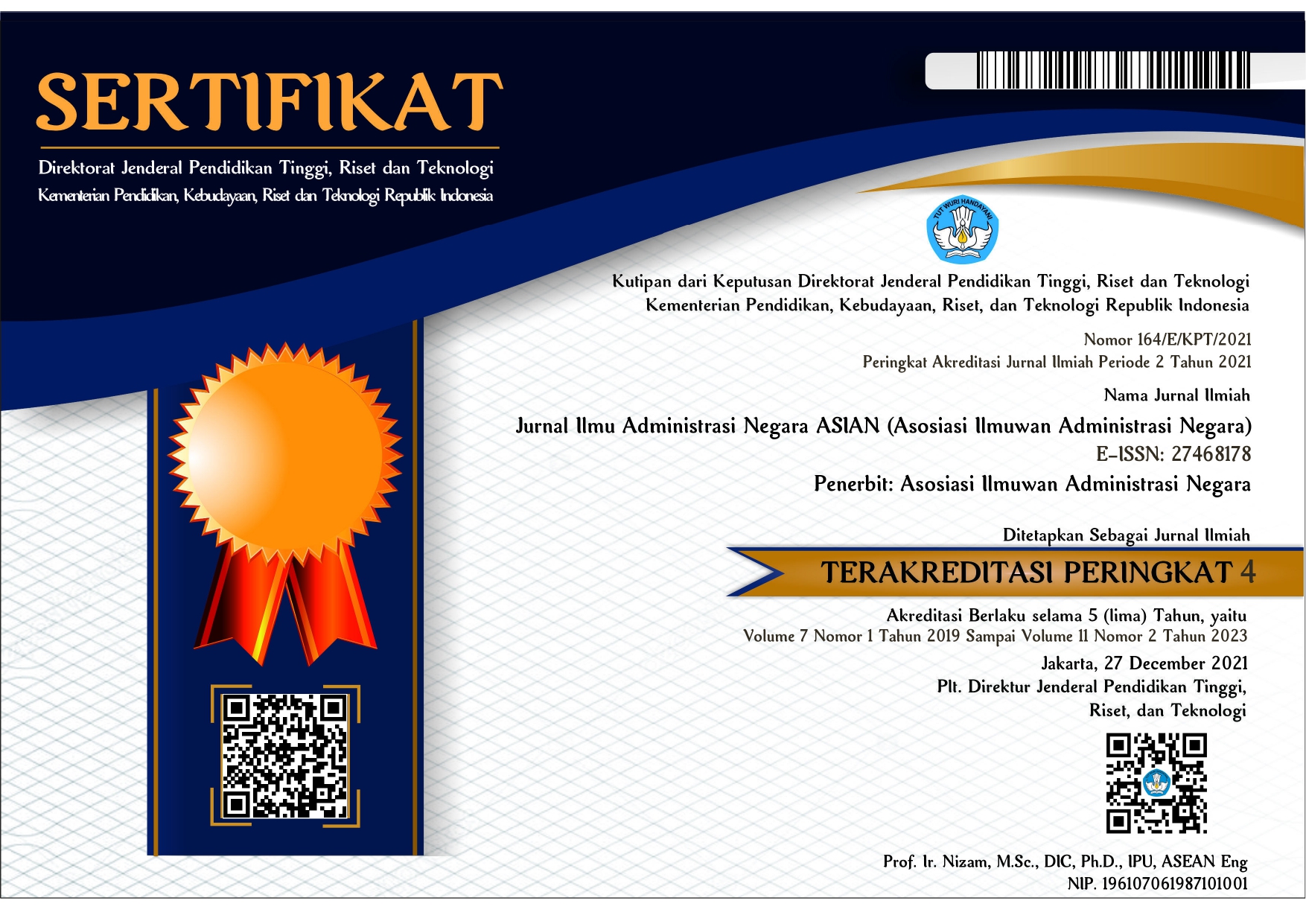Strategi Pengelolaan Pajak Daerah Dalam Upaya Peningkatan PAD di Kota Serang
 Abstract views: 794
,
Abstract views: 794
,
 PDF downloads: 1830
PDF downloads: 1830
Abstract
This study focuses on the analysis of local tax management strategies in an effort to increase PAD in Serang City. The theory uses SWOT analysis according to Hunger (2017: 23) which includes factors of strength (strength), weakness (weakness), opportunities (opportunities) and threats (threats). The research method uses case studies. The research approach uses a qualitative approach with a qualitative descriptive design. Research informants from BPKAD elements of Serang City, secretary of Commission III DPRD Serang City for Finance and Regional Assets, and hotel, restaurant and entertainment companies. Data analysis using data analysis techniques Miles and Huberman. The results of the study show that the SO (Strenghs to Opportunity) strategy is by adding local tax services that are carried out online, and adding new local taxpayers through data collection activities or direct surveys to the location of business activities engaged in hotels, restaurants and entertainment, WO strategy (Weakness to Opportunity) by adding field officers to carry out data collection and survey activities for business actors, especially small and medium-sized businesses that have not been registered as local taxpayers, ST Strategy (Strenghs to Threats) by utilizing the Serang City BPKAD website to periodic reporting of local taxes to the public, the WT (Weakness to Threats) strategy by means of publicity of local tax information can utilize print media and electronic media.
Downloads
References
Bogdan, Robet, Biklen, K. S. (2007). Qualitative research for education : an introduction to theories and methods | Bogdan, Robert; Biklen, Sari Knopp | download. Alien and Bacon, Inc, New York.
Bogdan, R., & Knopp, S. (2003). Qualitative Research for education : An Introduction to Theory and Methods. In Qualitative Research.
Haerah, K. (2017). Strategi Peningkatan Pendapatan Asli Daerah Dari Sektor Pajak Hotel Dan Restoran Di Kabupaten Jember. NASPA Journal, 42(1).
Hallett, D. J., Wheelen, T. L., & Hunger, J. D. (1990). Strategic Management and Business Policy (3rd Edition). The Journal of the Operational Research Society, 41(1). https://doi.org/10.2307/2582945
Hasanusi. (2015). Analisis Strategi Peningkatan Pendapatan Asli Daerah (PAD) di Kabupaten Lampung Barat. Jurnal Magister Manajemen, 01(1).
Kurniawati, M., & Toly, A. A. (2014). Analisis Keadilan Pajak, Biaya Kepatuhan, dan Tarif Pajak terhadap Persepsi Wajib Pajak Mengenai Penggelapan Pajak di Surabaya Barat. TAX & ACCOUNTING REVIEW, 4(2).
M, N. S. (2019). STRATEGI PENINGKATAN PENDAPATAN ASLI DAERAH (PAD) MELALUI INTENSIFIKASI DAN EKSTENSIFIKASI PENERIMAAN PAJAK DAN RETRIBUSI DAERAH DI KABUPATEN ENREKANG. JAKPP (Jurnal Analisis Kebijakan & Pelayanan Publik). https://doi.org/10.31947/jakpp.v1i1.6500
Mafaza, A., & Setyowati, K. (2020). COLLABORATIVE GOVERNANCE DALAM PENGEMBANGAN DESA WISATA. Jurnal Kebijakan Publik, 11(1). https://doi.org/10.31258/jkp.11.1.p.7-12
Mardiasmo. (2009). Akutansi Sektor Publik. Yogyakarta: Andi.
Siahaan, M. P. (2017). Pajak Daerah dan Retribusi. Jakarta: Raja Grafindo Persada. Retrieved from https://www.rajagrafindo.co.id/produk/pajak-daerah-dan-retribusi/
Sugiyono. (2016). Sugiyono, Metode Penelitian. Sugiyono.
Suriyankietkaew, S., & Petison, P. (2020). A retrospective and foresight: Bibliometric review of international research on strategic management for sustainability, 1991-2019. Sustainability (Switzerland). https://doi.org/10.3390/SU12010091
Copyright (c) 2021 Jurnal Ilmu Administrasi Negara ASIAN (Asosiasi Ilmuwan Administrasi Negara)

This work is licensed under a Creative Commons Attribution-ShareAlike 4.0 International License.
Authors who publish with this journal agree to the following terms:
1. Copyright on any article is retained by the author(s).
2. The author grants the journal, right of first publication with the work simultaneously licensed under a Creative Commons Attribution License that allows others to share the work with an acknowledgment of the work’s authorship and initial publication in this journal.
3. Authors are able to enter into separate, additional contractual arrangements for the non-exclusive distribution of the journal’s published version of the work (e.g., post it to an institutional repository or publish it in a book), with an acknowledgment of its initial publication in this journal.
4. Authors are permitted and encouraged to post their work online (e.g., in institutional repositories or on their website) prior to and during the submission process, as it can lead to productive exchanges, as well as earlier and greater citation of published work.
5. The article and any associated published material is distributed under the Creative Commons Attribution-ShareAlike 4.0 International License








